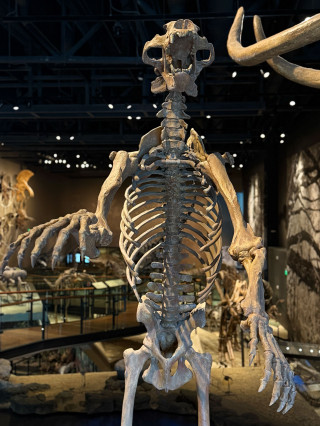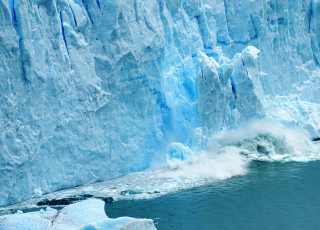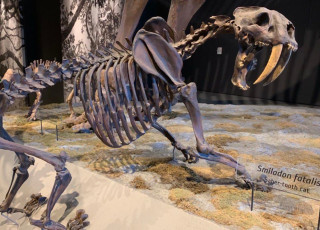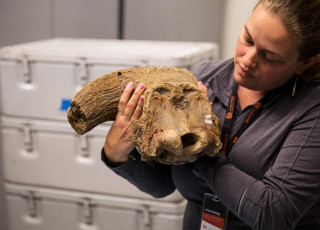Lake Bonneville Ice Age Safari
By Jude Coleman
Looking out from the Natural History Museum of Utah’s front walkway today, visitors are met with a sweeping view of the arid Salt Lake Valley. The Oquirrh Mountains flank hundreds of neighborhoods and businesses dotted with trees. But 20,000 years ago, gentle waves would have been lapping at their feet; Farnsworth Peak was a mere island in the distance, with water as far as the eye could see. The museum sits on the shoreline of what was once an ancient freshwater lake, the predecessor to Great Salt Lake: Lake Bonneville.
Lake Bonneville formed around 30,000 years ago when the climate became colder and wetter. Glacial melt water, rain and rivers filled the Salt Lake Valley, covering much of northern Utah west of the Wasatch range in a large lake. It wouldn’t just be the massive lake making the scene different. Long-extinct Ice Age animals roamed the landscape, many of which are relatives of animals on Earth today. If you took a safari around Lake Bonneville shoreline in the year 18,000 B.C.E, here are some of the critters you would see.
Columbian Mammoth
Mammoths are an iconic Ice Age species. But the ones that lived in Utah weren’t the shaggy haired woolly mammoths (Mammuthus primigenius) depicted in pop culture. Instead, it was Columbian mammoths (Mammuthus columbi) that trumpeted across the Southwest. These mammoths were slightly larger than their contemporary cousin, the African elephant. And instead of a thick coat of fur, they had short hair.
The behemoths would have stomped out paths around the lake that other animals could utilize as highways to the water. As big-time grazers, they also would have played a part in maintaining the open grasslands in the area by pulling down trees and smushing shrubs — just like elephants in savannas and forests today.
Western Camel

There are no native camels living in North America today, but the larger group they belong to, Camelidae, first evolved here 45 million to 50 million years ago. Those first camels were hardly recognizable as such, growing only a few feet tall and resembling a deer. But by the time of the Ice Age, camels looked much closer to their modern-day relatives.
“People think of camels as these exotic animals from Asia and North Africa,” said Randy Irmis, Curator of Paleontology at NHMU. “But they are truly a home-grown group of mammals that originated here in North America.”
The fossilized species found in Utah and throughout western North America is the western camel (Camelops hesternus). It was taller than camels alive today, and paleontologists aren’t sure if it had a hump. That’s because camels’ iconic curves are made of fat and soft tissue, which typically doesn’t preserve in the fossil record. But it’s possible, Irmis said — the western camel’s closest living relatives are the dromedary camel of the Sahara Desert and Bactrian camel of central Asia, both of which have humps. Western camels would have been browsers, nibbling on a variety of vegetation growing around the lake. The group evolved to thrive in a wide variety of habitats and migrated from their North American home turf to other continents before going extinct here around 12,000 years ago.
Harlan’s Muskox

While there are muskoxen alive today, they are limited to the Arctic. But the closely-related extinct muskox of the Ice Age (Bootherium bombifrons) lived far from the Arctic region in its time. The ancient ruminant was a little taller and leaner than modern muskox, but would have had a very similar diet.
“The fact that it's found here in Utah says something about the fact that the climate was very different,” said Irmis. It was much colder and wetter in western North America during the late Pleistocene.
Muskox fossils have popped up across the Salt Lake Valley for over 150 years. In fact, the first Ice Age fossil discovered in the area was a muskox. In 1871, workers uncovered a musk ox skull while digging a cellar near Temple Square. A century later, the skull came to rest at NHMU, where it remains today.
Giant Short-Faced Bear

Weighing in at 2,000 pounds, the giant short-faced bear (Arctodus simus) measured up to 11 feet tall when standing on its hind legs. For comparison, Utah’s neighborhood black bear males weigh only 300 pounds and are around as tall as a human when standing. Despite the cave bear’s bulk, they were largely herbivores, snacking on berries and vegetation. They did eat meat occasionally and may have even snagged a fish or two from the lake, Irmis said. Surprisingly, cave bears are most closely-related to South American spectacled bears, rather than the brown and black bears still living on our continent.
Jefferson’s Ground Sloth
Don’t let the name fool you: Pleistocene ground sloths were vastly different than the adorable tree-swingers in the jungle today. Although their closest relative is the three-toed sloth, ground sloths were closer in stature to a bear, weighing about 200 times more than arboreal sloths. As their name suggests, these extinct sloths walked on all fours instead of living in the trees. The sloth species of northern Utah was Jefferson’s ground sloth (Megalonyx jeffersonii), and paleontologists have found their fossils near Point of the Mountain — the ridgeline that divides Salt Lake Valley from Utah Valley.
Similar to modern sloths, Jefferson’s ground sloth had large claws for digging and ripping open tree trunks. The 10-foot-long, 2,000-pound herbivore ate a diet of leaves and other vegetation.
The sloth Megalonyx is named after Thomas Jefferson, who described its fossils from Virginia in one of the first paleontology publications in North America. Based on its enormous claws, Jefferson initially thought it belonged to a giant lion. Hence the name Megalonyx, derived from the Greek mega (meaning “large” or “great”) and onyx (meaning “claw” or “nail”).
You can learn more about Ice Age animals that once roamed the Earth in NHMU's new special exhibition, Mysteries of the Ice Ages, and it's permanent Past Worlds exhibition.
Utah preserves a treasure trove of these animals’ fossils — and many more — from the last Ice Age, and many of these fossils are cared for at NHMU. In part, that’s because many sediment deposits from 30,000 to 12,000 years ago still exist. Sediments prior to that time have largely eroded away. The extensive fossil record is also possible thanks to the sediments around and in Lake Bonneville. Animals that died on the shoreline could be preserved in the sand and gravel, or waves might have pulled their bones into the lake to be fossilized on the lakebed.
What happened to all these massive animals? Paleontologists are still trying to untangle the mystery. Roughly 12,000 years ago, humans showed up in the interior of the continent around the same time the megafauna went extinct. Hunting, therefore, might have played a role. The climate also shifted at this time, marking the beginning of the Holocene Epoch with warmer, drier conditions. That means their habitat and food sources would have changed.
“They all disappeared in Utah by about 12,000 years ago,” said Irmis. “The hard part is teasing out the relative contributions of climate change versus human hunting.”

Learn More in Mysteries of the Ice Ages
Delve deeper into the Ice Ages in our special exhibition open now through January 4, 2026.




